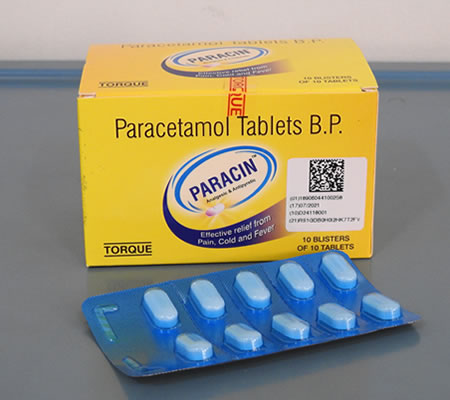COMPOSITION:
Each uncoated tablet contains:
Paracetamol BP 500mg
DESCRIPTION:
Paracetamol, a para-aminophenol derivative produces antipyresis by acting on the hypothalamic heat regulating center and analgesia by elevating the pain threshold.

MECHANISM OF ACTION
Prostaglandis are associated with the development of pain. Paracetamol inhibits the synthesis of prostaglandins, thus producing analgesia, In fever prostaglandin acts with in the hypothalamus to produce the resultant elevation of body temperature by the processes that appear to be mediated by the cyclic AMP Paracetamol suppresses this response by inhibiting the synthesis of prostaglandins.
PHARMACOKINETICS:
Paracetamol is metabolized primarily by the hepatic microsomal enzymes.Paracetamol is rapidly and almost completely absorbed from the gastrointestinal track. The concentration in plasma reaches a peak in 10 to 60 minutes and the half-life in plasma is about 1 to 3 hours after therapeutic doses.
Paracetamol is relatively uniformly distributed throughout the most body fluids. Binding of drug to plasma proteins is variable, only 20 to 50% may be bound at the concentrations encountered during acute intoxication.
After therapeutic doses, 90 to 100% of the drug may be recovered in the urine with in the first day, primarily after hepatic conjugation with glucuronic acid(about 60%), sulphuric acid (about 35%), or cysteine (about 3%); small amount of hydroxylated and deacetylated metabolites have been detected. A small proportion of paracetamol oxidized via the heptic cytochrome P-450 to a chemically reactive intermediate N-acetyl-benzoquinone-imine, which is detoxified by conjugation with glutathione. when a very large dose of paracetamol is taken, hepatic glutathione is depleted and the access reactive arylating intermediates covalently binds to proteins in liver cells (and renal tubes), thereby causing necrosis.
INDICATION
Paracetamol, a para-aminophenol derivative, has analgesic and antipyretic properties and weak anti-inflammatory activity, Paracin is recommended for the treatment of mild to moderate pain and febrile conditions, for example headace, toothache, backache, sore throat, colds, influenza, rheumatic pain and dysmenorrhoea.
DOSAGE AND ADMINISTRATION
One-two tablets 3-4 times a day or as directed by the physician.
CONTRAINDICATIONS:
Patients with known hypersensitivity to paracetamol.PRECAUTION: Paracin should be given with care patients with impaired kidney or liver function and patients with alcohol dependence.
SIDE-EFFECT:
These are usually mild though it may cause haematological reactions including thrombocytopenia, Ieucopenia, Pancytopenia, neuthropenia and agranulocytosis. Skin rashes and other hypersensitivity reactions occur occasionally. Overdose of paracetamol can result in several liver damage.
STORAGE:
Paracin should be stored below 25 degree Celsius, in dry and dark place.
Keep out of reach of children.
PRESENTATION:
10×10 Tabs. Blister pack
